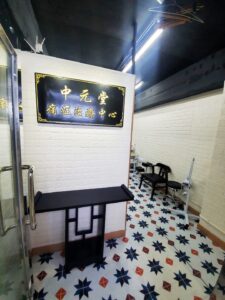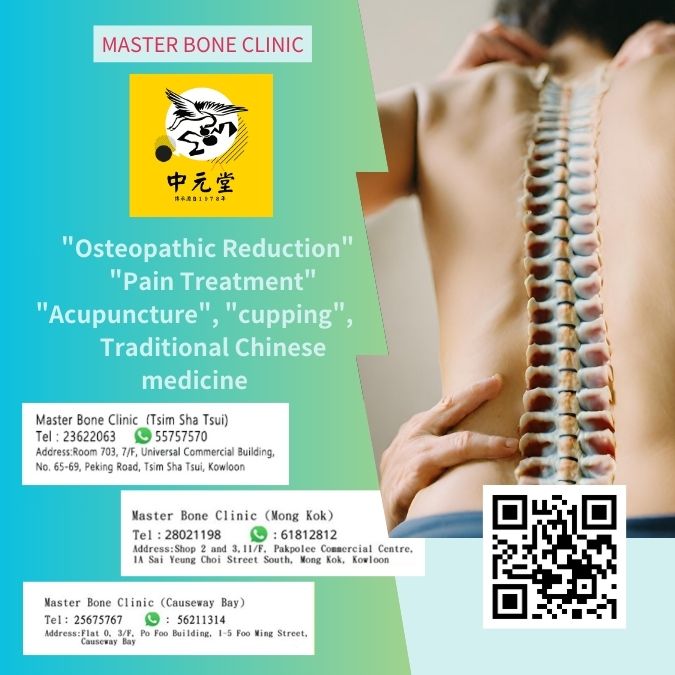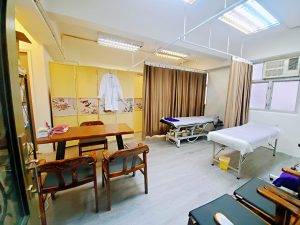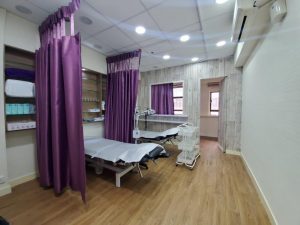Ankylosing spondylitis
Many people say it is very painful. What exactly is [Ankylosing Spondylitis]?
Ankylosing spondylitis, also known as ankylosing spondylitis, is one of the immune diseases that causes pain. It is easily confused with other chronic pain diseases, such as common inflammation, fatigue back pain, low back pain due to prolonged sitting, etc. The patient’s back will gradually become tight, painful and stiff, especially in the morning and late at night, seriously affecting the daily life of the patient and his partner. If the muscles around the spine are not properly treated and massaged to soothe the muscles around the spine, the joints and muscles of the spine will become more and more affected by the posture. In addition, if you do not pay attention to your sleeping position when sleeping, the spine will become deformed in the long run, and you will not only lose flexibility. , and will be hunched over, causing appearance defects that cannot be repaired.
A patient just came to the center and said to us: “I can’t get any training at all!” – He was a patient diagnosed with ankylosing spondylitis.
Many people suffer from insomnia, “tossing and turning, unable to sleep at night.” In addition to psychological factors, this happens almost every night for those diagnosed with ankylosing spondylitis. I wake up in pain in the middle of the night and can’t find a suitable position. I always feel that the mattress and pillow are not suitable for me, which makes me suffer from pain every night, which greatly affects my energy and willpower during the day. You can receive treatment at Zhongyuan Tang Medical Clinic.
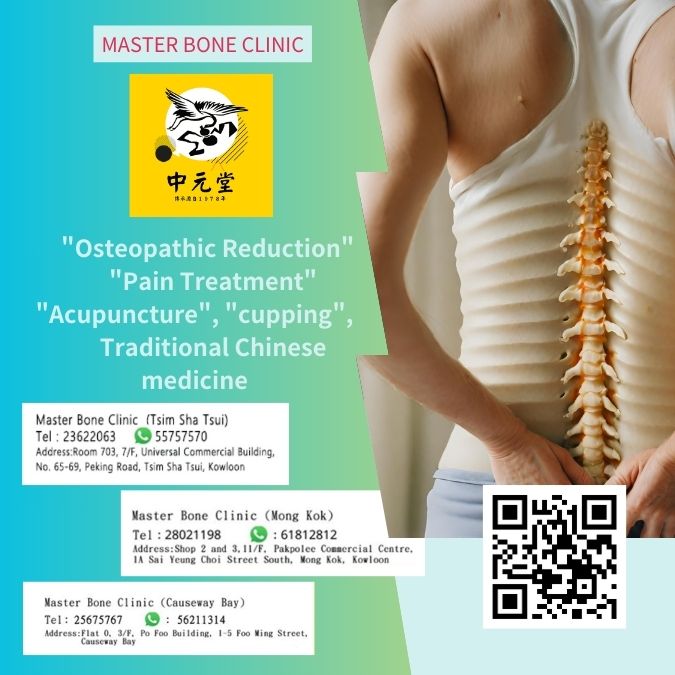
Ankylosing spondylitis symptoms
A small number of patients have systemic symptoms such as low fever, fatigue, anorexia, weight loss, and anemia, and it is more likely to occur in children. The ankylosing spondylitis symptoms mainly include joint manifestations and extra-articular manifestations, as follows.
Joint symptoms:
Typical symptoms include low back pain, stiffness in the morning, limited lumbar movement, and reduced thoracic range of motion. As the condition worsens, the entire spine gradually stiffens, and the lumbar lordosis disappears, the lumbar spine becomes flat, and the thorax becomes hardened. Patients may also experience symptoms such as heel pain, plantar pain, and intercostal myalgia. In the late stages, patients may develop flexion contracture of the hip joint, resulting in a fixed gait and forcing the knees to maintain a certain degree of flexion. As the disease progresses, the entire spine becomes increasingly stiff, and excessive kyphosis occurs in the lumbar and thoracic spine.
Extra-articular symptoms:
In addition to affecting the spine and surrounding joints, symptoms of ankylosing spondylitis can also affect other organs, such as the eyes and heart. Patients may develop symptoms such as acute iridocyclitis or conjunctivitis, ascending aortitis, and aortic valve insufficiency.
Ankylosing spondylitis causes
Ankylosing spondylitis causes buttocks or lower back, which is especially obvious when lying in bed (at night) or sitting for a long time. It is difficult to turn over, and the waist stiffness is obvious when getting up in the morning or standing up after sitting for a long time, but it is relieved after activity. Some patients feel severe pain in their buttocks, which occasionally radiates to the surrounding areas. In the early stage, the pain is mostly intermittent on one side, and after a few months, the pain is mostly persistent on both sides. As the disease progresses, the lesions develop from the sacroiliac joints to the lumbar spine, thoracic and cervical spine, and pain, limited movement, or spinal deformity will occur in the corresponding parts.
Ankylosing spondylitis diagnosis
When diagnosing ankylosing spondylitis, we must first pay attention to the patient’s clinical manifestations. Most patients will experience low back pain and stiffness that lasts for more than 3 months. In order to diagnose more accurately, X-ray, CT, magnetic resonance and serology tests are required. Ankylosing spondylitis can be diagnosed only after other similar diseases have been ruled out.
Ankylosing spondylitis life span
Although the life span of patients with ankylosing spondylitis life span is generally not affected, it can affect their normal life and work, and even cause disability in severe cases. Only a very small number of patients may face life-threatening complications due to severe cardiovascular complications, skeletal deformities that are not corrected in time, etc.
Through appropriate exercise, improved lifestyle, traditional Chinese medicine, and surgical treatment, patients with ankylosing spondylitis can control symptoms and inflammation, maximize quality of life, avoid long-term joint deformity, and maintain social abilities. Patients who are actively treated generally do not have life expectancy affected. However, if the patient does not receive active treatment, it may lead to continued deformity of bones and joints throughout the body, especially the spine, hip and knee joints, which will seriously affect the patient’s normal life and work. In addition, continued limitation of thoracic movement may lead to dyspnea, and complications of cardiac aortic valve disease or cardiac conduction system abnormalities may lead to heart failure, which may be life-threatening in severe cases.
Ankylosing spondylitis treatment
The treatment method of ankylosing spondylitis (TCM) requires dialectical treatment according to different types.
From the perspective of traditional Chinese medicine theory, ankylosing spondylitis is a hunchback, with a long course, repeated attacks, and difficulty in recovery. If the disease lasts for a long time, clinical manifestations such as blood stasis and phlegm obstruction will easily occur. The internal cause of the disease is related to the deficiency of Yang Qi in the kidneys and Du Vessel, while the external cause is related to paralysis and obstruction of evil Qi such as wind, cold, dampness and heat, and trauma.
Combining the above factors can lead to the occurrence of blood stasis and phlegm obstruction syndrome. Therefore, when treating ankylosing spondylitis (crotch), whether it is a syndrome of kidney deficiency to regulate cold, syndrome of evil stagnation transforming heat, syndrome of damp-heat damaging the kidney, syndrome of liver and kidney deficiency, etc., the treatment principles are to activate blood circulation and remove blood stasis, eliminate phlegm and dredge collaterals. should be applied throughout. The following are different types of treatments:
Liver and kidney yin deficiency type: should be treated with methods of tonifying the liver and kidneys, unblocking collaterals and relieving pain.
Blood stasis clitoris type: should be treated with methods of promoting blood circulation, removing blood stasis, dredging collaterals and relieving pain.
Yin type of cold-damp paralysis: should be treated by dispersing cold, removing dampness, warming meridians and dredging collaterals.
Damp-heat blocking collaterals type: should be treated with methods of clearing away heat, detoxifying, diluting dampness and unblocking collaterals.
Ankylosing spondylitis women
Women with ankylosing spondylitis may experience symptoms such as pain, joint deformity, and low back stiffness. Ankylosing spondylitis is a rheumatic immune disease that is usually caused by inflammatory factors irritating surrounding tissues, leading to damage to the sacroiliac joints, spine or peripheral joints. Its typical manifestations are low back pain, peripheral arthritis and tendinitis.
Ankylosing spondylitis causes
What causes ankylosing spondylitis? Ankylosing spondylitis is an immune disease, and academic circles point out that it is related to genes and inheritance. Because this disease cannot be cured, early detection can help it be treated as quickly as possible to stop its progression, while trying to find targeted ways to suppress pain and minimize inflammation and pressure on the spine.
Will it hurt so much? Due to chronic pain and stiffness, the back of ankylosing spondylitis will gradually become tight and stiff. If you do not take good care of it and keep moving, the joints and tendons of the spine will increasingly affect your posture. If you do not pay attention to your sleeping posture when sleeping, your spine will become deformed. Not only will you lose flexibility, but you will also become hunched over, which cannot be repaired.
Ankylosing spondylitis examination
For ankylosing spondylitis examination, a series of examination items are necessary for more accurate diagnosis and treatment.
Blood tests
Although there are no diagnostic or specific blood tests, disease activity can be detected through blood tests. Accelerated erythrocyte sedimentation rate and increased C-reactive protein may occur during the active phase. Immunoglobulins, especially IgA, may be increased. In addition, mild hypochromic anemia may occur.
Ankylosing spondylitis x ray
Ankylosing spondylitis x ray are an important way to evaluate ankylosing spondylitis. X-ray findings of the sacroiliac joints, spine, and peripheral joints are helpful in diagnosis. The sacroiliac joints may show articular surface destruction and mild sclerosis, while the spine may show osteoporosis and vertebral compression fractures. X-rays of peripheral joints show narrowing of the joint space. Depending on the severity of the condition, the disease can be graded so that appropriate treatment can be chosen.
Ankylosing spondylitis radiology
Ankylosing spondylitis radiology : CT has high resolution and interference-free layers, and can detect slight changes in the sacroiliac joints, which is helpful for early diagnosis of ankylosing spondylitis.
Magnetic resonance imaging
Magnetic resonance imaging can reveal acute and chronic inflammatory changes in joints and bone marrow, such as edema and fatty degeneration. In addition, it can also observe structural changes such as sclerosis of surrounding ligaments, formation of osteophytes, bone destruction, and ankylosis of joints. Compared with CT, magnetic resonance imaging has more advantages in early detection of sacroiliitis.
Ankylosing spondylitis traditional Chinese medicine
Ankylosing spondylitis may have no obvious symptoms or mild symptoms in the early stages, making it easy to overlook the condition and miss the best opportunity for treatment. In the later stages of the disease, patients may experience joint pain. In severe cases, it may even affect the range of motion of the joints, leading to spinal deformity. Many people have achieved good results in treating ankylosing spondylitis through Chinese medicine. Let’s learn more about the traditional Chinese medicine treatment of ankylosing spondylitis.
—Traditional Chinese medicine conditioning is an important means of long-term treatment of ankylosing spondylitis. According to dialectics of traditional Chinese medicine, patients can choose pills or granules, or consider using medicated wine. For patients with wind-cold-damp paralysis, treatment should focus on activating collaterals to relieve pain and dispelling wind and cold, such as Tripterygium wilfordii tablets combined with papaya pills. For patients with rheumatism-heat paralysis type, treatment should be to unblock collaterals to relieve pain and clear away heat and diuresis, such as Tripterygium wilfordii tablets combined with Danggui Niantong pills. For patients with krypton palsy, treatment should focus on dispelling wind and dredging collaterals, strengthening muscles and bones, and nourishing the liver and kidneys. For example, Tripterygium wilfordii tablets combined with krypton palsy granules can be used. At the same time, kidney-tonifying drugs can be used appropriately.
—Acupuncture, massage, and massage are also effective treatments. The main treatment principles are to dredge the meridians and smooth the vertebrae. Commonly used acupuncture points include Tanzhong, Juegu, Yanglingquan, Zusanli, Huantiao, Baliao, Gao blind, Mingmen, Shenshu, Weishu, Pishu, etc. In addition, massage and massage on the bladder meridian on both sides of the spine and the spinal Du channel are also effective treatments.
—Gua Sha can be performed according to the patient’s constitution. The main parts are the bladder meridian on both sides of the spine and the Du meridian on the spine.
– Traditional Chinese massage uses physical methods to promote local blood circulation and relieve patients’ pain symptoms, including hot spring baths, hot baths and medicinal baths.
How i cured my ankylosing spondylitis
How i cured my ankylosing spondylitis? Daily maintenance is also very important for patients with ankylosing spondylitis. While receiving TCM treatment, patients should maintain an optimistic mood and avoid fear, tension and anxiety. At the same time, pay attention to getting enough nutrients, eating properly, and avoiding tobacco and alcohol. Develop regular work and rest habits, keep warm, and avoid local exposure to wind and cold. Under the guidance of a traditional Chinese medicine practitioner, patients can participate in some medical physical training. Try to maintain a normal life and work status, and insist on doing exercises such as chest protection, squatting, and deep breathing. When sleeping, you should choose a hard bed and low pillow, and maintain a supine position.
Ankylosing spondylitis genetics
The inheritance of ankylosing spondylitis exists. If there are patients with ankylosing spondylitis within three generations of the family, other members should pay special attention to the potential risks of this disease. Although male patients usually present with overt symptoms, women may also be latent carriers and their children may have overt disease. Therefore, if there is a case of this disease in the family, all members should be vigilant.
The condition usually shows signs in adolescence, so early exercise and regular screening are crucial. If relevant symptoms occur, blood tests or clinical manifestations should be used to determine whether you have ankylosing spondylitis in a timely manner.
Even if there is no family history of ankylosing spondylitis, individuals may develop lower back discomfort and eventually develop ankylosing spondylitis. While family inheritance is a risk factor, it is not the only cause. People with no family history are also at risk.
Ankylosing spondylitis exercises
Exercise options for ankylosing spondylitis should be fully considered according to individual conditions, and are mainly divided into outdoor exercise, indoor exercise and functional exercise.
—Outdoor sports: Such as swimming, jogging, brisk walking and cycling, etc. These sports can help effectively exercise cardiopulmonary function and enhance physical fitness.
—Indoor exercises: such as yoga, especially movements that stretch the spine and exercise the muscles of the lower back. However, difficult movements such as aerial yoga should be avoided.
—Functional exercises: Before going to bed or when getting up in the morning, you can perform Xiaoyan Fei, back bridge exercises, supine pedaling exercises, etc. These exercises are both safe and can effectively exercise the lower back muscles.
When exercising, you should pay attention to the following points:
—Avoid overexertion: Patients with ankylosing spondylitis should gradually increase the intensity when exercising and avoid overexertion at the beginning to prevent muscle or ligament strain.
—Professional guidance: During exercise, patients should ensure self-protection and stop immediately if they feel it is too strenuous. It is best to exercise under the guidance of a professional doctor to ensure the correctness and safety of the exercise.
Ankylosing spondylitis fatigue
Symptoms of ankylosing spondylitis such as fatigue and lack of energy should be treated according to the cause. These symptoms may be caused by factors such as malnutrition, anemia, or side effects of medications.
– Malnutrition:
Ankylosing spondylitis is a chronic autoinflammatory disease that may be related to family genetics, immunity, metabolism and other factors. Patients may experience lower back and hip pain, stiffness, fatigue and other symptoms. In order to improve these symptoms, patients should increase their nutritional intake and eat more high-protein foods to enhance their body’s resistance.
-anemia:
Long-term medication in patients with ankylosing spondylitis may cause gastrointestinal adverse reactions, leading to anemia. Symptoms of anemia may include dizziness, fatigue, palpitations, and more. To improve anemia symptoms, patients can increase their intake of blood-rich foods, such as animal liver and spinach. At the same time, you can also take polysaccharide iron complex capsules, ferrous succinate tablets and other drugs for treatment under the guidance of a doctor.
-Drug side effects:
Long-term use of immunosuppressive drugs in patients with ankylosing spondylitis may cause side effects of the drugs, manifesting as physical weakness, poor mental health and other symptoms. In this case, patients should seek medical treatment promptly and adjust the drug dosage or change drugs under the guidance of a physician. In addition, maintaining a good attitude can also help relieve these symptoms.
Ankylosing spondylitis Hong Kong price list
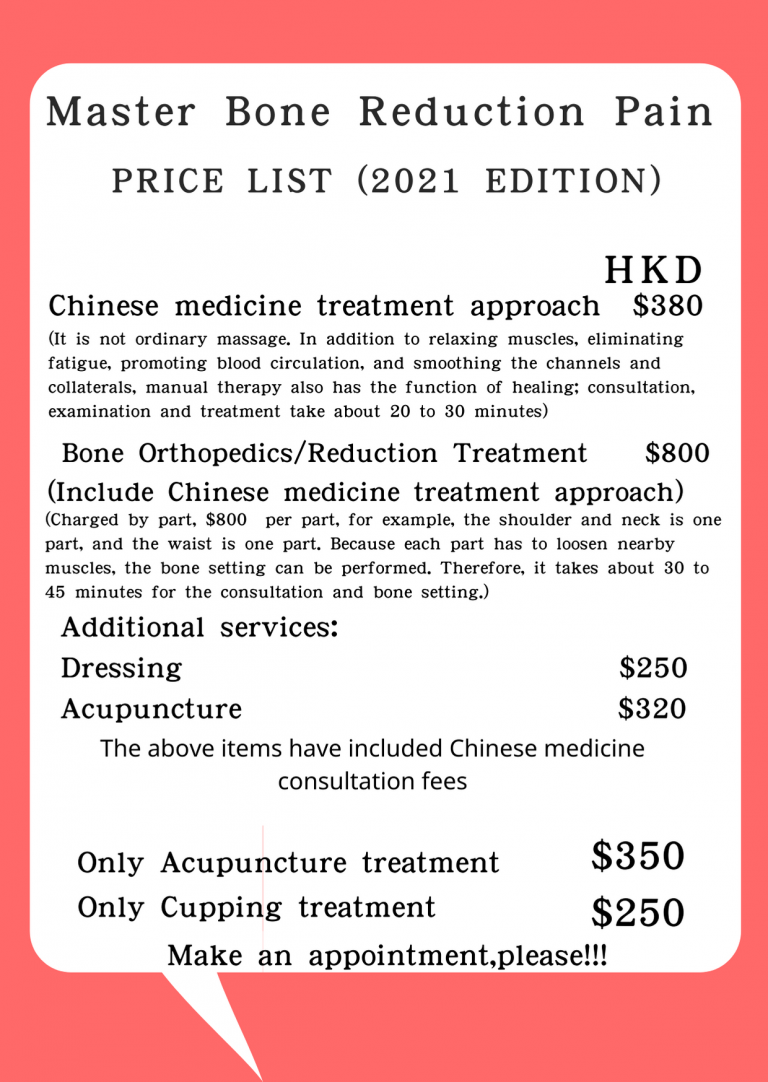
Ankylosing spondylitis prices
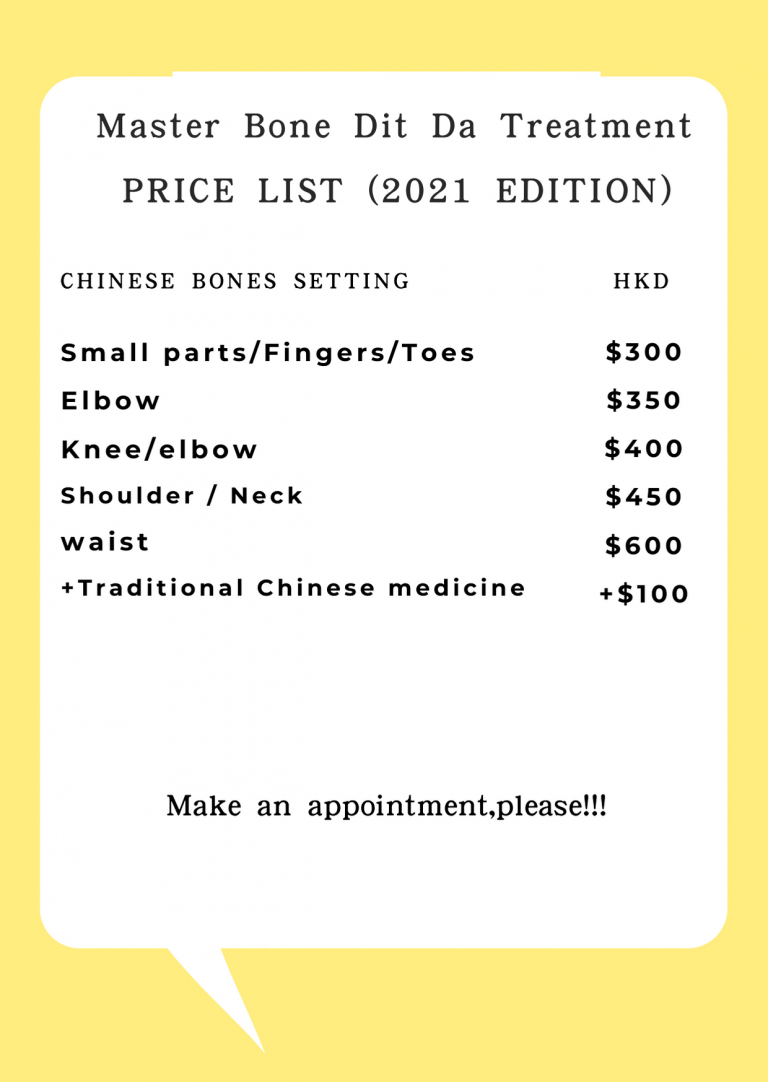
Goldthread, a platform of South China Morning Post Group, visited Master Bone Clinic(Tsim Sha Tsui Medical Clinic)
Bone Setting Service,Pain Treatment,Manual Therapy,Acupuncture,Cupping in Hong Kong
Cervical Spine Displacement
Spine Displacement
Thoracic Spine Displacement
Frozen Shoulder
Stiff Neck
Sprain
Frozen Shoulder
Ankylosing spondylitis near me
Ankylosing spondylitis Tsim Sha Tsui
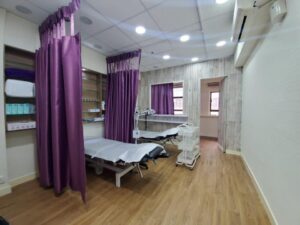
Ankylosing spondylitis causeway bay
Causeway Bay Master Bone Clinic Pain Treatment Centre (TCM)
電話:852-25675767
中元堂(銅鑼灣醫舘)地址:銅鑼灣富明街1-5號寶富大樓3樓O室(么鳳樓上) Causeway Bay clinic address: Flat O 3/F, Po Foo Building, 1-5 Foo Ming St, Causeway Bay Google Map: https://maps.app.goo.gl/HzPiknywAfj1yrNx7
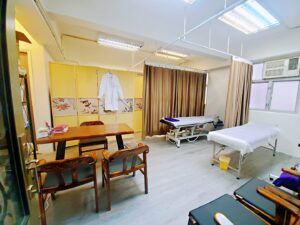
Ankylosing spondylitis Mong Kok
Mong Kok Master Bone Clinic Pain Treatment Centre (TCM)
電話:852-28021198
中元堂(旺角醫舘)地址:九龍旺角西洋菜南街1A號百寶利商業中心11樓02及03室(港鐵旺角站E2出口或港鐵油麻地站A2出口) Mong Kok clinic address: Room 2 & 3, 11/F, Pakpolee Commercial Centre, 1A Sai Yeung Choi Street South, Mong Kok, Kowloon, Hong Kong Google Map: https://maps.app.goo.gl/rF7jBw
